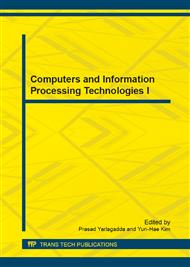[1]
A. Sahai and B. Waters: Fuzzy Identity Based Encryption. In Eurocrypt 2005, pages 457-473. Springer, (2005).
DOI: 10.1007/11426639_27
Google Scholar
[2]
V. Goyal, O. Pandey, A. Sahai and B. Waters: Attribute-Based Encryption for Fine-Grained Access Control of Encrypted Data. In ACM Conference on Computer and Communications Security 2006, pages. 89-98, (2006).
DOI: 10.1145/1180405.1180418
Google Scholar
[3]
J. Bethencourt, A. Sahai and B. Waters: Ciphertext-Policy Attribute-Based Encryption. In IEEE Symposium on Security and Privacy 2007, pages. 321-334, (2007).
DOI: 10.1109/sp.2007.11
Google Scholar
[4]
L. lbraimi, M. Petkovic, S. Nikova, P. Hartel, and W. Jonker: Mediated Ciphertext-Policy Attribute-Based Encryption and Its Application. In International Workshop Information Security Applications 2009, pages 309-323, (2009).
DOI: 10.1007/978-3-642-10838-9_23
Google Scholar
[5]
B. Waters: Ciphertext-Policy Attribute-Based Encryption: An Expressive, Efficient, and Provably Secure Realization. In Public Key Cryptography 2011, vol. 6571, pages 53-70, Springer, (2011).
DOI: 10.1007/978-3-642-19379-8_4
Google Scholar
[6]
J. Hur and D. K. Noh: Attribute-Based Access Control with Efficient Revocation in Data Outsourcing Systems. In IEEE Transactions on Parallel and Distributed Systems, vol. 22, No. 7, pages. 1214-1221, (2011).
DOI: 10.1109/tpds.2010.203
Google Scholar
[7]
S. Yu, C. Wang, K. Ren, W. Lou: Attribute Based Data Sharing with Attribute Revocation. In ASIACCS'10, pages. 261-270, (2010).
DOI: 10.1145/1755688.1755720
Google Scholar
[8]
J. Hur: Improving Security and Efficiency in Attribute-Based Data Sharing. In IEEE Transactions on Knowledge and Data Engineering, vol. 25, No. 10, pages. 2271-2282, (2011).
DOI: 10.1109/tkde.2011.78
Google Scholar
[9]
R. Bobba, H. Khurana and M. Prabhakaran: Attribute-Sets: A Practically Motivated Enhancement to Attribute-Based Encryption. In European Symposium on Research in Computer Security 2009, LNCS 5789, pages. 587-604, (2009).
DOI: 10.1007/978-3-642-04444-1_36
Google Scholar
[10]
S. Rafaeli, D. Hutchison: A Survey of Key Management for Secure Group Communication. In ACM Computing Surveys, vol. 35, No. 3, pages. 309-329, (2003).
DOI: 10.1145/937503.937506
Google Scholar
[11]
S. Yu, C. Wang, K. Ren and W. Lou: Achieving Secure, Scalable, and Fine-grained Data Access Control in Cloud Computing. In IEEE INFOCOM 2010 Proceedings, pages. 1-9, (2010).
DOI: 10.1109/infcom.2010.5462174
Google Scholar
[12]
J. Hur, D. Koo, S. O. Hwang and K. Kang: Removing Escrow from Ciphertext Policy Attribute-Based Encryption. In Computers and Mathematics with Applications 2013, vol. 65, No. 9, pages. 1310-1317, (2013).
DOI: 10.1016/j.camwa.2012.02.005
Google Scholar


